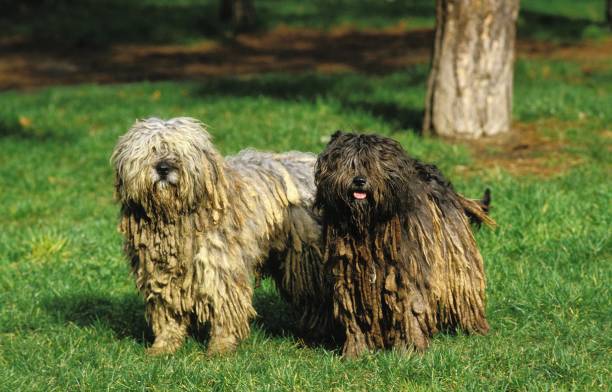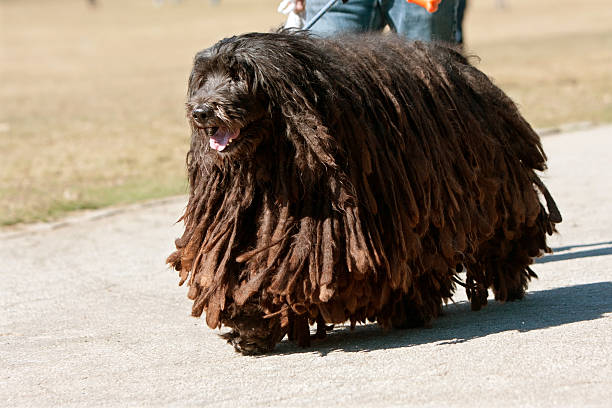Bergamasco Sheepdog

Breed History:
The Bergamasco Sheepdog is an ancient herding breed that originated in the Italian Alps near Bergamo, where it was developed to herd and guard livestock in the harsh mountain environment. Known for its intelligence, resilience, and unique coat, the Bergamasco was highly valued by shepherds for its independence and problem-solving skills. Over centuries, the breed evolved into a reliable working dog, capable of managing flocks without constant human direction.
The most striking feature of the Bergamasco is its dense, matted coat, which naturally forms flocks or cords that protect it from cold weather and predators. Today, while still rare, the breed is gaining popularity as a loyal and calm family companion. Recognised for its serene temperament and strong bond with its people, the Bergamasco combines ancient working instincts with a surprisingly adaptable and affectionate personality.
|
Gender |
Height |
Weight |
|
Male |
58–62 cm |
32–38 kg |
|
Female |
54–58 cm |
26–32 kg |
Size – Medium-Large
Life Expectancy: 13–15 years

Breed Appearance:
The Bergamasco Sheepdog has a distinctive appearance, most notably its long, felted coat made of three types of hair—woolly, oily, and harsh—that naturally weave into dense mats or flocks. These flocks start developing around one year of age and continue forming throughout the dog’s life, providing insulation and protection. The coat, often grey or merle in colour, gives the Bergamasco a rugged, almost primitive look that reflects its working heritage.
Underneath the coat, the Bergamasco has a sturdy, muscular body with a broad chest and strong limbs. Its expressive, oval-shaped eyes are often hidden beneath hair, but they convey warmth and intelligence. The tail is thick at the base and carried low, while the overall body structure is balanced and powerful, built more for endurance than speed.
Breed Type – Family/Guard:
The Bergamasco is a calm, watchful, and deeply loyal breed, originally bred to think and act independently while guarding livestock. It bonds closely with its family and is particularly gentle with children, making it a stable and affectionate family dog. Though not aggressive, it is naturally protective and alert, often wary of strangers without being reactive.
This breed thrives in a home where it is treated as part of the family and given meaningful interaction. Its gentle, balanced temperament makes it suitable for families seeking a quiet, steady companion that can also serve as a watchdog. While not a typical “guard dog” in the aggressive sense, it is deeply intuitive and naturally protective.

Training:
The Bergamasco Sheepdog is intelligent and learns quickly, but its independent nature requires a patient and respectful training approach. It was bred to make decisions on its own while working, so it may not respond to repetitive or overly rigid commands. Instead, it thrives under positive reinforcement, trust-based training, and tasks that engage its natural problem-solving abilities.
Consistency, gentle guidance, and early socialisation are key to raising a well-rounded Bergamasco. While not stubborn, the breed does best with confident owners who understand how to channel its intelligence. It generally gets along well with other pets when introduced properly and is rarely aggressive or reactive without reason.
Health & Care:
The Bergamasco is a generally healthy breed with few inherited health problems, thanks to its centuries of natural development and selective breeding. However, like all dogs, it can be prone to some issues, such as hip dysplasia or bloat. Regular check-ups, a healthy diet, and appropriate exercise help ensure long-term well-being.
The most unique aspect of the Bergamasco care is its coat. While it appears high-maintenance, once fully formed, the flocks require surprisingly little grooming. They do not need brushing, but should be separated occasionally by hand to prevent excessive matting. The coat also doesn’t shed much and is naturally dirt-repellent. Regular checks of the ears, nails, and teeth round out its care needs.

Living Conditions:
The Bergamasco adapts well to various living situations, from countryside homes with land to more suburban environments. While it can live in an apartment, it thrives best in a home with access to a yard or outdoor space. It is not a high-energy breed, but it does need moderate daily activity to stay mentally and physically balanced.
This breed prefers being close to its family and does not enjoy being left alone for long periods. A peaceful, structured home with consistent interaction suits it best. The thick coat allows it to tolerate cold weather well, but it can also adapt to moderate heat if provided with shade and water.
Exercise:
While not hyperactive, the Bergamasco Sheepdog benefits from daily moderate exercise to maintain health and prevent boredom. Long walks, playtime in the yard, or mentally stimulating activities like scent work or problem-solving games are ideal. It doesn’t require intense workouts, but regular movement is essential for its joints and overall well-being.
As a working dog at heart, the Bergamasco enjoys having a task or a sense of purpose. While it doesn’t typically exhibit destructive behaviour, it may become restless or withdrawn if under-stimulated. Off-leash play in safe areas is great, as the breed is generally not prone to wandering far from its people.
Grooming:
The Bergamasco’s signature coat may seem complex, but it is relatively low-maintenance once matured. As the coat cords naturally, owners should help separate and shape the flocks manually during the dog’s first year to prevent matting. Once mature, the coat should be checked regularly, but does not require brushing or trimming.
Bathing is only necessary a few times per year, as the coat repels dirt and water naturally. Drying can take a long time, so baths should be planned accordingly. Routine care should include nail trimming, ear cleaning, and regular dental hygiene to maintain overall health. Though grooming is different from most breeds, it becomes manageable with consistency.

Advantages:
-
Extremely loyal and forms strong bonds with its family
-
A calm, steady temperament is ideal for children and quiet households
-
Naturally protective without being aggressive or reactive
-
Unique, non-shedding coat that’s dirt-repellent and low-odour
-
Adaptable to different home environments with sufficient companionship
-
Minimal barking and a peaceful presence in the home
Disadvantages:
-
Coat requires hands-on care during early development and occasional maintenance afterwards
-
Independent nature may be challenging for inexperienced owners
-
Needs close companionship—can develop separation anxiety if left alone too long
-
May be reserved or aloof with strangers if not properly socialised
-
Grooming routine is unique and may be unfamiliar to most dog owners
-
Slow drying after baths due to the dense, flocked coat

